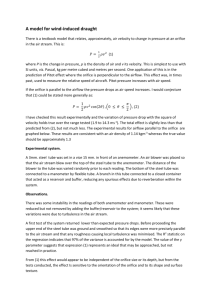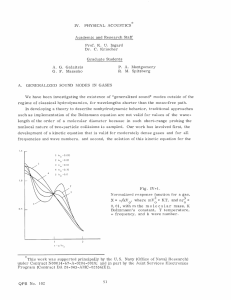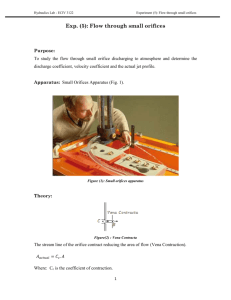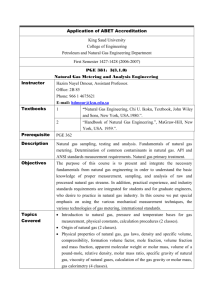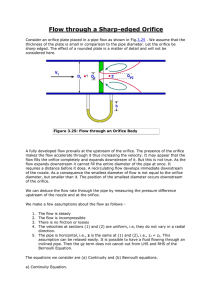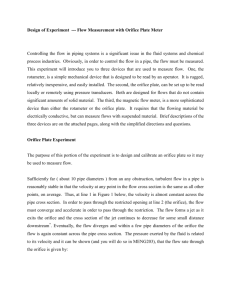ACOUSTICS VI. Academic and Research Staff
advertisement
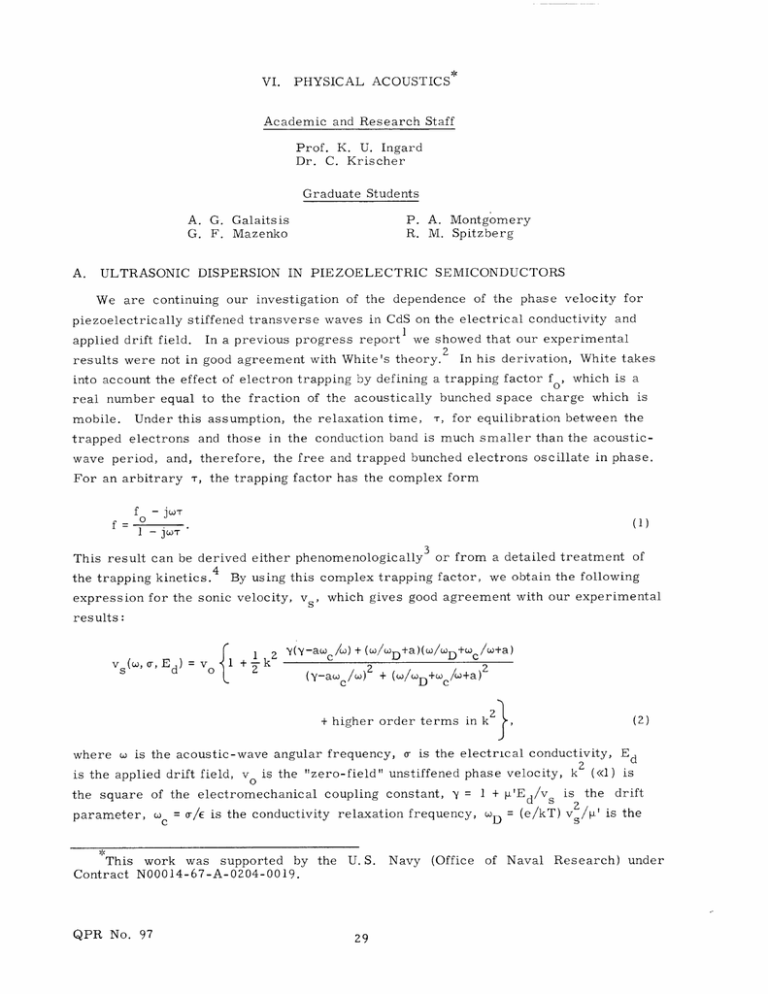
VI. PHYSICAL ACOUSTICS Academic and Research Staff Prof. K. U. Ingard Dr. C. Krischer Graduate Students P. A. Montgomery R. M. Spitzberg A. G. Galaitsis G. F. Mazenko A. ULTRASONIC DISPERSION IN PIEZOELECTRIC SEMICONDUCTORS We are continuing our investigation of the dependence of the phase velocity for piezoelectrically stiffened transverse waves in CdS on the electrical conductivity and In a previous progress report1 we showed that our experimental results were not in good agreement with White's theory.2 In his derivation, White takes into account the effect of electron trapping by defining a trapping factor fo, which is a applied drift field. real number equal to the fraction of the acoustically bunched space charge which is mobile. Under this assumption, the relaxation time, T, for equilibration between the trapped electrons and those in the conduction band is much smaller than the acousticwave period, and, therefore, the free and trapped bunched electrons oscillate in phase. For an arbitrary f f= T, the trapping factor has the complex form - jWT o 1 - jWT (1) This result can be derived either phenomenologically 3 or from a detailed treatment of the trapping kinetics.4 By using this complex trapping factor, we obtain the following expression for the sonic velocity, v s , which gives good agreement with our experimental results: v s Ed) (W + E)Iy( y-awc/w) (w/wD+a)(w/woD c/w+a) c/w+a) 2 (y-a c/)2 + (/WD + higher order terms in k2} , (2) where w is the acoustic-wave angular frequency, a is the electrical conductivity, Ed 2 is the applied drift field, v 0 is the "zero-field" unstiffened phase velocity, k (<<1) is the square of the electromechanical coupling constant, y = 1 + 'Ed/V s is the drift ' parameter, wec = a/E is the conductivity relaxation frequency, WD = (e/kT) vs/p is the This work was supported by the Contract N00014-67-A-0204-0019. QPR No. 97 U. S. Navy (Office of Naval Research) under -0.5 H- z w C-) r w >w -10 I -1.5 -0.5 -1.0 DRIFT Fig. VI- 1. -0.5 -I .5 FIELD (kV/cm) -1.0 DRIFT -1.5 FIELD (kV/cm) Variation of phase velocity with applied drift field and electrical conductivity, for a 32-MHz transverse wave in CdS at -5 (a) -1 The value for o- is 1.3 X 10 - 5 cm O Theoretical curves calculated from Eq. 2, 20. 00C. 0. 18, T = 2. 6 ns, k -1 using f = 1.75 km/s. = o Values calculated using T = 0 and f = 0. 68 2 = 0. 036, v O for t, obtained independently from ultrasonic amplification measurements at 406 MHz, vary from 2062 -1 -1 332 cm V s over the conductivity range 1 -c to 1024 a . (b) Theoretical curves were adjusted to give the same effective drift mobility as in (a). QPR No. 97 (VI. diffusion frequency, a = (1-f ) w/(f 2+ ' 2 /(o+2 2)]. PHYSICAL ACOUSTICS) is the effective drift mobility, and +wT). Measurements of the dependence of the ultrasonic velocity on the applied drift field were carried out over the frequency range 32-345 MHz, conductivities from 10 -5 to 10 -z 2 -1 cm -1 . and over a range of electrical With the aid of a visual curve-fitting pro- gram on a computer with CRT output display, we found that Eq. 2 provided a good fit to the data over the entire range of measurement, with the values f o = 0. 18 and T = 2. 6 ns used. Figure VI-la shows the experimental sponding theoretical curves, above used. results obtained at 32 MHz, calculated from Eq. 2, with the values for fo and T given For comparison, the same data are shown in Fig. VI-ib, oretical curves calculated for and the corre- but with the the- 7 = 0 (White's theory). We wish to express our gratitude to M. Beeler of Project MAC, an M. I. T. Research project sponsored by the Advanced Research Projects Agency, Department of Defense, under Office of Naval Research Contract Nonr-4102(02), for his kindness in providing the curve-fitting program. C. Krischer References 1. C. Krischer, Quarterly Progress Report No. 95, Research Laboratory of Electronics, M. I. T. , October 15, 1969, p. 27. 2. D. L. White, J. Appl. Phys. 33, 2547 (1962). 3. I. Uchida, T. Ishiguro, Y. Sasaki, and T. Suzuki, J. Phys. Soc. 4. C. A. A. J. Greebe, Philips Res. Rep. 21, 1 (1966). B. NONLINEAR SOUND TRANSMISSION THROUGH AN ORIFICE When sound of sufficiently high amplitude orifice in a plate, As a result, is transmitted through a sharp-edged flow separation will occur, flow through the orifice is Japan 19, 674 (1964). and the velocity of the oscillatory no longer linearly related to the incident sound pressure. the transmitted sound will be distorted so that its frequency spectrum will be different from that of the incident sound. This effect has been studied experimentally for the case in which the incident sound is a pure tone. In this experiment the orifice plate was set across a duct that was terminated by a 100% absorber.1 The experimental results are shown in Figs. VI-2 and VI-3. drop in sound-pressure level across the orifice plate is level of the driving sound pressure. QPR No. 97 In Fig. VI-2 the shown as a function of the This result refers to the frequency (150 Hz) (VI. PHYSICAL ACOUSTICS) of the incident sound. At sound-pressure levels about 130 dB we note that AL increases with the sound-pressure level, reaching a value of ~22 dB when the driving pressure level is 162 dB. sound- In other words, this nonlinear "transmission loss" is ~18 dB larger than the linear value. In Fig. VI-3 the spectrum of the transmitted sound pressure when the driving pressure level is 162 dB at a frequency of 150 Hz is shown. mitted spectrum contains a large number of harmonics We note that the trans- and that the odd harmonics predominate. In attempting to understand these results, we shall assume oscillations through the orifice can be treated quasi-statically. steady flow characteristic relating pressure drop and flow is that the acoustic This means that the assumed valid also in the acoustic case. Thus, if the sound pressure on the "upstream" and "downstream" sides of the orifice are P uo = C 1 and P3' 1 1 the average velocity in the orifice is given by 3 , (1) where C 1 is an orifice coefficient, C1 = 0. 61. Since on the downstream side the sound-pressure field is an outgoing wave (no reflections), we have P 3 = (Ao/A 1 )pcuo' (2) where Ao is the orifice area, A l is the duct area, speed of sound. from Eqs. If we also include an inertial component in the air flow, puo IuJ m and c is the it follows I and 2 that we can relate P1 and Uo through the equation P1 1 where t p is the air density, C 2C2 1 du A + Al pcu + pt cuo m is a characteristic ddt (3) thickness of the orifice (including mass end correction). We now wish to determine the time dependence of the orifice velocity, u o , that corresponds to a harmonic driving pressure pl = Ptot cos wt. We shall not solve Eq. 3 in its complete form here, but consider only the high-intensity region in which the first term predominates. u nd e tcos C The time dependence of the orifice velocity is then simply ete wt We expand this in a Fourier series QPR No. 97 = u max cos (4) 15 10 oN, 110 120 130 140 201og (p / Fig. VI-2. 150 160 170 ) re,,f (dB) Sound-pressure level difference 20 log (pl/p ) 2 between the two sides of a thin orifice plate in a duct as a function of the sound-pressure level 20 log (p 1 /Pref) on the source side of the plate. Orifice diameter 0. 7 cm; duct diameter 6. 2 cm; frequency 150 Hz. Pref = 0. 0002 dyn/cm. FUNDAMENTAL 5 Fig. QPR No. 97 VI-3. 7 9 11 13 15 Recorded spectrum of pressure wave transmitted through the orifice plate at 162 dB driving soundpressure level. (VI. PHYSICAL ACOUSTICS) u (t) = Z U cos nwt and obtain U n U n max =T/2 4 rJ (cos x) [( (1-4n ) n cos nx dx 0 8 N- U 1/a 1+2n)r( 1-2n 4 (n even) 2z 8 \2fY = 4 3,] 2 U The first few harmonic components 3 3 of the velocity 1.11 3 3.4 U (n odd) =0 where 1 is the gamma function. are U=-l 1 -1] 4 -i 7 3 5 5 77 7 77 U 1 3 1' Having obtained the frequency spectrum of the velocity in the aperture, we can determine the corresponding spectrum of the transmitted sound pressure from A Pt = f Pn cos Wt Pn 0 (8) pcU nn . It follows that the relative strength of the pressure amplitudes is obtained from the result in Eq. 7. The odd harmonics First, we note that the even harmonics are absent. decrease with the order n approximately as 1/n harmonic is chosen as reference, seventh harmonics are -18 2 for large n. dB, -24. 6 dB, and -29. experimental results. QPR No. 97 only 6. 6 dB. and 2 dB. In other words, there is a large drop of 18 dB in level between the first and the third, between the third and the fifth is If the level of the first 0 dB, we see that the levels of the third, fifth, This is whereas the level difference in excellent agreement with (VI. PHYSICAL ACOUSTICS) In order to determine the absolute level of the transmitted sound in terms of the driving pressure PI, we have to solve for uoo0 in Eq. 3 and use it in Eq. level regime such that pu /2C2 >>(A /A 1 ) pcu , that is, ptm duo/dt, the calculation is simple and we get u0 = C 1 P3 A 1 pcC > (A /A) u 2p/p 1. In the high- 2 2C c and pu /2C 2 and 1 (9) P 3 /pc 2 p 1l/pc = C 1 (A /A 1) 2 The corresponding pressure-level difference in this high-level region can be expressed as 20 log (pl/P 3 ) =-20 log (pl/Pref) + 20 log (A 1 /AoC where pref = 0. 0002 dyn/cm . 1) - 98. 5, (10) This expression shows that the pressure-level difference across the plate increases with the level of the driving pressure, an increase of 5 dB for every increase of 10 dB in the pressure level, in excellent agreement with experiments. The absolute value of the predicted level difference is approximately 2 dB higher than the observed value in this high-level region. In view of several possible sources of error, this may be regarded as reasonably good agreement. U. Ingard References 1. U. Ingard and H. Ising, J. QPR No. 97 Acoust. Soc. Am. 42, 6-17 (1967).
